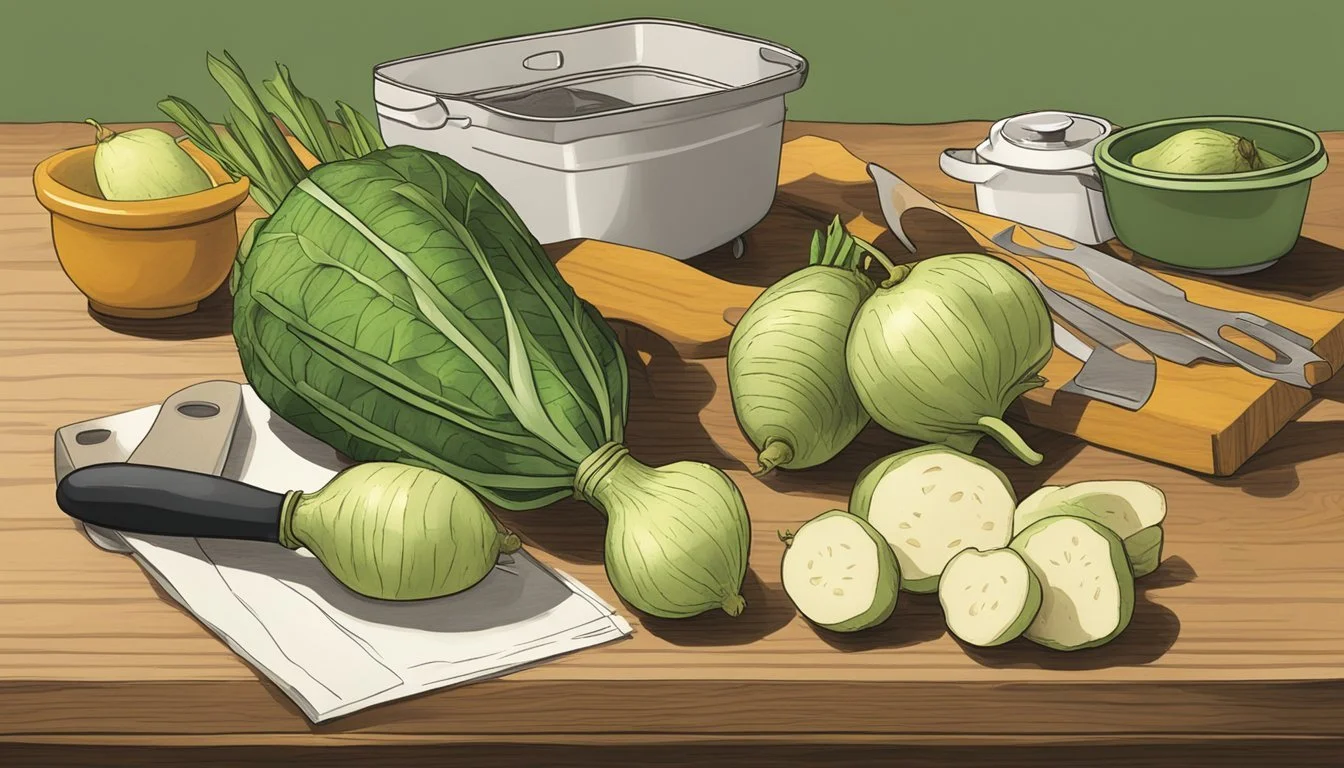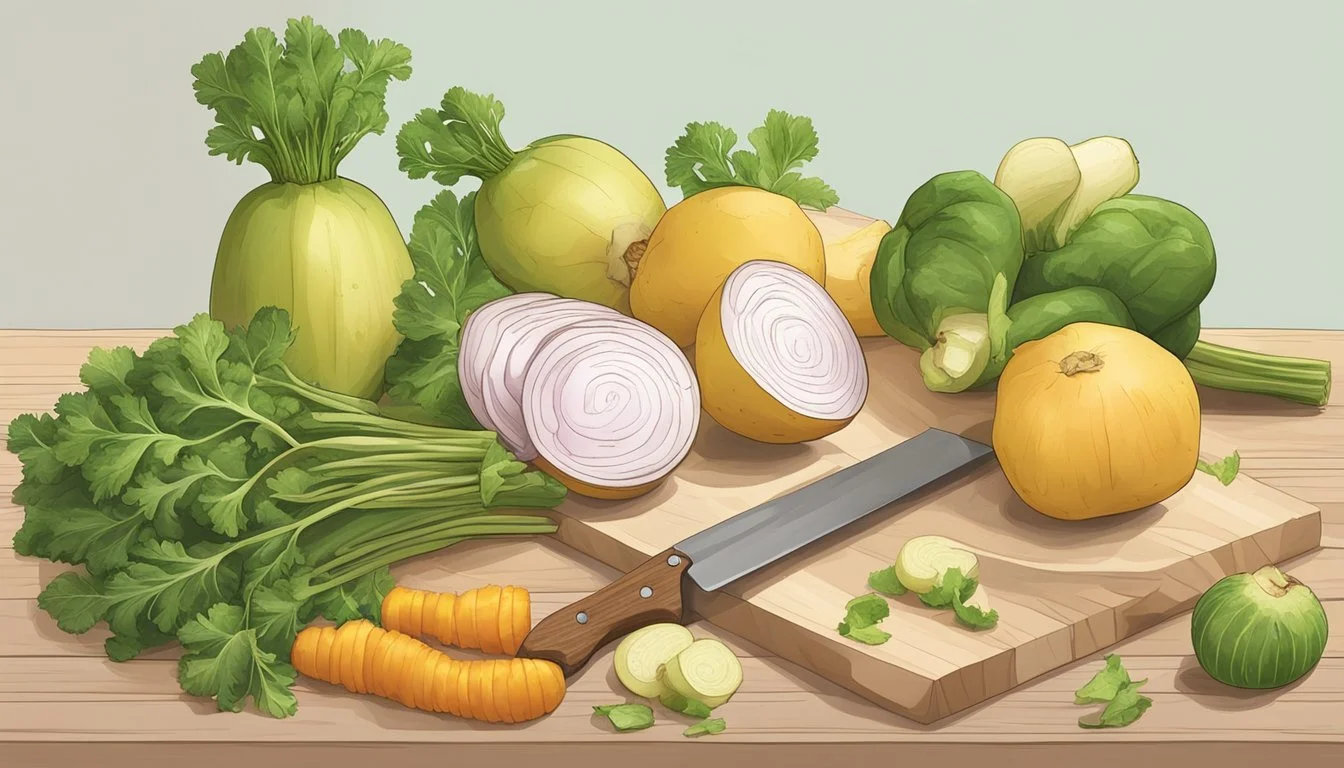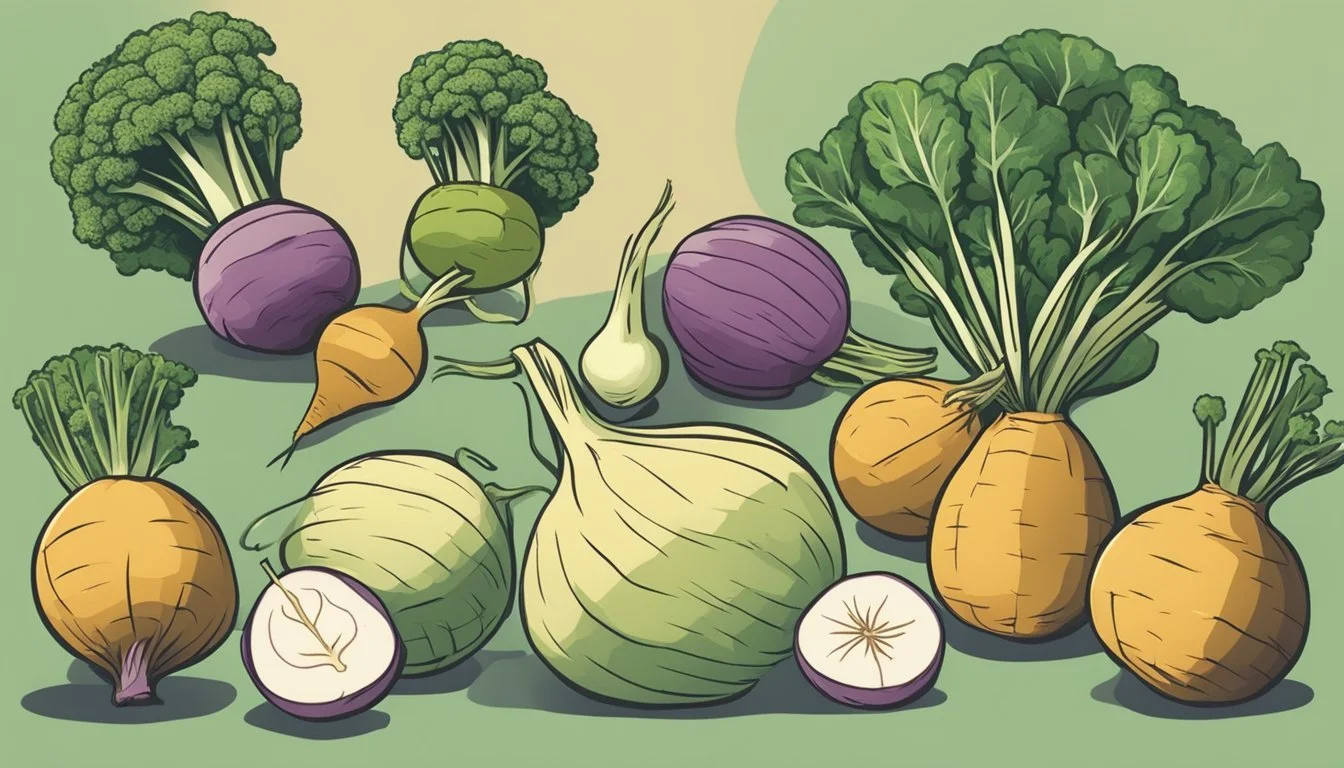Rutabagas Substitutes
Best Alternatives for Cooking and Nutrition
If you're in the middle of preparing a dish that calls for rutabaga, but you realize you're out of this versatile root vegetable, don't worry. There are several excellent substitutes that can provide the same delicious flavor, nutrition, and texture. Turnips, parsnips, sweet potatoes, carrots, kohlrabi, and butternut squash are just a few options that can fill the rutabaga-shaped gap in your recipes.
These substitutes not only match the culinary characteristics of rutabaga but also offer their unique benefits. For example, parsnips and turnips are root vegetables like rutabaga, providing a similar texture and slightly sweet flavor. Kohlrabi and butternut squash, on the other hand, bring their own distinct flavors and nutritional profiles to the table, enriching your dishes in delightful ways.
Exploring these alternatives can lead to exciting variations in your cooking. Whether you're making a hearty stew, a creamy mash, or a simple roasted veggie platter, knowing the best rutabaga substitutes ensures you can create tasty and nutritious meals without missing a beat.
Understanding Rutabagas
Rutabagas, also known as swedes or Swedish turnips, are a versatile root vegetable with a mild, earthy flavor. They are packed with nutrients and used in various culinary applications, from soups to stir-fries.
Nutritional Profile
Rutabagas are low in calories yet rich in essential nutrients. They are an excellent source of vitamin C, which supports immune health.
They also contain a good amount of dietary fiber, aiding digestive health, and potassium, which helps with muscle function. Additionally, rutabagas provide smaller amounts of minerals such as magnesium and calcium.
Their nutritional profile makes them a valuable addition to any diet, especially for those seeking nutrient-dense, low-calorie food options.
Culinary Uses
Rutabagas are highly versatile in the kitchen. They can be mashed like potatoes, creating a creamy side dish. Rutabaga fries are another popular option, ideal for a healthy snack.
Incorporating rutabagas into soups and stews imparts a subtle sweetness and hearty texture. They can also be thinly sliced or grated for salads and stir-fries.
When cooked, their flesh becomes tender and mildly sweet, perfect for roasting or boiling. Their adaptability makes them a staple in various culinary traditions.
Rutabaga Varieties
There are several varieties of rutabagas, each with slight differences in flavor and texture. The common variety has yellow flesh with purple-tinged skin, often referred to as a yellow turnip.
Other types may have white or orange flesh, each offering unique culinary benefits. Despite these differences, all varieties share the same basic nutrient profile and versatility in cooking.
Common Substitutes for Rutabaga
When looking for substitutes for rutabaga, consider the flavor profile and texture to ensure the replacement fits well in your dish. Here are some options that fall into three main categories: root vegetables, cabbage family alternatives, and starchy alternatives.
Root Vegetable Alternatives
Turnips are a solid choice as they share a similar taste and texture with rutabagas. Use a one-to-one ratio when substituting turnips for rutabagas. Turnips can be roasted, mashed, or added to stews.
Parsnips offer a slightly sweeter option. They have a distinct carrot-like appearance and creamy flesh, and can be used in both sweet and savory applications.
Celery Root (Celeriac) has a crisp texture and mild flavor that makes it suitable for salads, soups, and purees. It’s a versatile root vegetable that pairs well with a variety of seasonings.
Cabbage Family Alternatives
Kohlrabi is a member of the Brassica family and can serve as a good substitute for rutabagas. It has a mild flavor akin to turnips and can be used raw or cooked. Ensure to peel the tough outer skin before using it.
Broccoli Stems can be an innovative substitute. Though not a root vegetable, their texture is similar, and they can absorb flavors well in cooked dishes. They can be steamed, stir-fried, or added to soups.
Cauliflower can mimic the creamy texture when mashed or the crunch when roasted. Though the flavor is more neutral, it works well in a variety of dishes that typically use rutabagas.
Starchy Alternatives
Sweet Potatoes provide a sweeter, starchy alternative, perfect for dishes requiring a rich, creamy consistency. They can be roasted, mashed, or baked.
Butternut Squash can be used in place of rutabagas in soups, stews, or roasted dishes. Its slightly sweet flavor and smooth texture make it an ideal substitute.
Potatoes are another common alternative. They are starchy and can be used in the same way as rutabagas, particularly in mashed dishes or stews.
Jicama offers a crunchy texture that is great for raw applications or lightly cooked dishes, providing a refreshing, slightly sweet taste.
Incorporating these alternatives into your recipes can help maintain the desired flavor and texture when rutabagas are not available.
Preparation and Cooking Tips
Rutabagas are incredibly versatile and can be prepared in a variety of ways. Proper preparation and cooking are key to enhancing their flavors, whether they are used in stews, soups, or roasted dishes.
Prepping Root Vegetables
Rutabagas have a thick skin that should be peeled before cooking. Use a sturdy peeler or a sharp knife to remove the outer layer. Once peeled, they should be cut into uniform pieces for even cooking. Smaller pieces are ideal for boiling and mashing, while larger chunks work well for roasting.
For stews and casseroles, cutting rutabagas into medium-sized cubes ensures they maintain their shape and texture throughout the cooking process. Washing the pieces thoroughly under cold water before cooking helps remove any residual dirt and bitterness.
Cooking Techniques
Boiling: Boiled rutabagas are perfect for mashing. Place peeled and chopped pieces in a pot of salted water. Boil until tender, typically 20-30 minutes. Drain and mash with butter and seasoning.
Roasting: Roasted rutabagas develop a sweeter, more concentrated flavor. Toss pieces in olive oil, salt, and pepper. Roast in a 400°F oven for 35-45 minutes, turning occasionally for even browning.
Stews and Soups: Adding rutabagas to soups and stews imparts a mild yet slightly peppery flavor. Ensure pieces are evenly cut to match cooking times of other vegetables in the dish. Simmer until all ingredients are tender.
Other Techniques: Rutabagas can also be incorporated into casseroles and curries. These methods allow the vegetable to soak up surrounding flavors, providing a complementary sweetness and texture.
Seasoning and Flavor Pairings
Rutabagas have a mild, slightly bitter taste that benefits from the right seasoning. Salt and pepper are essential, but other spices can enhance their natural flavors. Thyme, rosemary, and garlic work well in roasted dishes.
Butter and cream can make mashed rutabagas rich and smooth. For a spicy twist, add a dash of cayenne or paprika. The sweet undertone of rutabagas pairs well with honey or maple syrup in glaze recipes.
In soups and curries, combining rutabagas with cumin, coriander, and turmeric can create a complex flavor profile. Their versatility makes them an excellent addition to a variety of dishes.
Health Benefits and Considerations
Rutabagas offer various health benefits that contribute to overall well-being. They are rich in essential nutrients, help prevent chronic diseases, and support digestive health.
Dietary Importance
Rutabagas are low in calories and packed with essential nutrients. They provide a significant amount of fiber, which promotes good digestion and helps maintain healthy blood sugar levels. This root vegetable is also rich in Vitamin C, aiding in immune function and skin health.
Vitamins and minerals present in rutabagas include potassium, which supports muscle function and heart health. The presence of magnesium and calcium contributes to the maintenance of strong bones and effective bodily functions.
Nutrition Facts per 100g of Rutabaga:
Nutrient Amount Calories 38 kcal Fiber 2.3g Vitamin C 25mg Potassium 305mg Calcium 43mg Magnesium 20mg
Preventing Health Issues
The nutrients in rutabagas can help mitigate various health problems. Their anti-inflammatory properties due to antioxidants and Vitamin C are known to reduce chronic inflammation, a risk factor for many diseases including heart disease. The low-carb and low-calorie nature of rutabagas make them a suitable choice for weight management and diabetes control.
Regular consumption of rutabagas and other fibrous vegetables can reduce the risk of certain cancers. Fiber aids in preventing colon cancer by promoting regular bowel movements. Moreover, the high level of potassium supports cardiovascular health and can help lower blood pressure.
Rutabagas not only provide nutritional benefits but also play a role in preventing significant health issues, making them a valuable addition to any balanced diet.
Global Cuisine and Rutabaga
Rutabagas find their way into various global cuisines, bringing a unique blend of sweetness and earthiness. This section explores the versatile applications of rutabaga in Asian cuisine, traditional Western dishes, and as a key ingredient in salads and slaws.
Asian Cuisine Influences
Rutabagas can replace ingredients like daikon radish and korean radish in many Asian dishes. For example, in Japanese cuisine, thinly sliced rutabaga can serve as a crunchy addition to sushi rolls or as a topping for sashimi. Additionally, rutabagas work well in Korean kimchi recipes, offering a unique twist on the classic fermented vegetable dish.
In stir-fries, roasted rutabagas provide a delicious alternative to traditional Asian vegetables, adding both texture and flavor. They absorb sauces well, complementing a variety of Asian spices and herbs. Incorporating rutabaga into these recipes allows for innovative takes on familiar dishes.
Traditional Western Dishes
In Western cuisine, rutabagas are often featured in hearty dishes. Mashed rutabaga acts as a creamy side, similar to mashed potatoes but with a distinctive taste. Rutabaga fries serve as a healthier alternative to traditional potato fries, retaining a crisp texture while offering a different flavor profile.
Rutabagas are also a key ingredient in pasties, a classic pastry filled with savory meat and vegetables. Roasted rutabagas mixed with turnip greens make for a delightful side dish, pairing well with roasted meats such as chicken or beef. These applications highlight the versatility of rutabaga in a Western culinary context.
Salad and Slaw Options
Rutabagas can transform simple salads and slaws into flavorful dishes. Shredded rutabaga adds a crunchy texture to slaws, pairing well with ingredients like carrots and cabbages. Black radish and turnip can also be included for added variety and nutritional benefits.
For salads, thinly sliced or julienned rutabaga brings a crispness that enhances the overall dish. Combining rutabaga with other root vegetables creates a robust and satisfying salad, perfect for a light meal or a side dish. These preparations showcase the adaptability of rutabaga in fresh, raw applications.
Purchasing and Storing Tips
It's essential to select high-quality rutabagas for the best culinary results. Proper storage methods will ensure that your rutabagas stay fresh and flavorful for as long as possible.
Selecting Quality Rutabagas
When purchasing rutabagas, look for ones that have smooth, unblemished skin. The rutabaga's skin should be firm and free of any cuts or soft spots, as these can indicate spoilage or mishandling. Pay attention to the weight and size; a good rutabaga will feel heavy for its size, indicating dense flesh.
Avoid rutabagas with excessive wax coating since this might be a sign of long storage or inferior quality. While some wax is normal for preservation, a heavy coating can affect the taste. Opt for rutabagas that have a uniform shape and color for the best texture and flavor.
Storage Methods
To preserve the freshness of rutabagas, store them in a cool, dark place with adequate ventilation. The refrigerator's crisper drawer is ideal. Wrap them loosely in a plastic bag to maintain moisture levels. Properly stored rutabagas can last up to two weeks in the refrigerator.
For long-term storage: you can freeze rutabagas by peeling and cutting them into cubes, blanching them in boiling water for 2-3 minutes, then rapidly cooling them in ice water. Drain thoroughly before placing in airtight containers or freezer bags. Frozen rutabaga can last for several months without losing flavor or texture.
Consumer Insights
The demand for rutabaga substitutes is reflected in evolving market trends and consumer feedback. This section highlights the preferences and comments shared by users on these alternatives.
Market Trends
Recent market trends show an increase in the popularity of rutabaga substitutes. Consumers are seeking versatile options that offer similar flavors and textures.
Popular choices include turnips, parsnips, and kohlrabi due to their comparable taste profiles. Turnips, in particular, are a frequent substitute because they belong to the same vegetable family.
Parsnips and salsify also attract attention for their unique flavors and uses in various dishes.
Retailers report increased sales in these vegetables, indicating strong market demand for these alternatives. The trend towards plant-based diets aids the growth of this niche market.
User Comments and Feedback
Consumers often praise the texture and taste of turnips as a replacement for rutabagas. Many reviews highlight how turnips seamlessly blend into recipes without compromising flavor.
Parsnips receive positive comments for their distinct sweetness and versatility in cooking, such as roasting and mashing. Kohlrabi garners favorable feedback for its crisp texture and mild taste, ideal for raw and cooked applications.
Some users note that celeriac offers a milder flavor, making it suitable for soups and stews. Customer reviews emphasize high user satisfaction with these substitutes, reflecting a broad acceptance of various alternatives depending on the recipe requirements.
消费者对萝卜和防风草有特别高的评价,指出这些替代品在负责方面表现出色。







